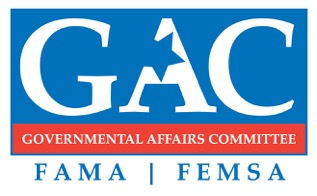From the late 1980s through the 1990s, FAMA (Fire Apparatus Manufacturers’ Association) and FEMSA (Fire and Emergency Manufacturers and Services Association) supported their own legislative/government affairs committees (GAC) that focused on matters unique to each association.
In the summer of 2000, the fate of the Firefighter Investment and Response Enhancement (FIRE) Act was dependent on the effectiveness of the fire service in grassroots lobbying. FAMA and FEMSA immediately aligned themselves with several influential fire organizations. Collectively, they were credited with the successful passage of the FIRE Act. Not long after, several pieces of legislation were introduced that affected both the FIRE Act (aka Assistance to Firefighters Grant Program, or AFG) and the industry over the next few years. Throughout that time, FAMA and FEMSA maintained their presence among constituents in the fire service.
Summer of 2004
Evening with Congress
Initiatives of the FEMSA GAC, led by then-chair and Board Member, Steve Lawrence (Spec Rescue International), delivered a successful “Evening with Congress” in the summer of 2004. The reception hosted congressional members and staffers to introduce FEMSA as a resource while introducing members to business practices of Congress. FAMA members were invited to participate and engage as a unified voice for the fire industry. Based on the success of this event, FAMA’s then-GAC chair, John Sztykiel (Spartan Motors), approached FEMSA’s GAC leadership with the thought of forming a combined GAC. Both Boards were pursued and then directed their committees to explore how the new joint committee would work. After numerous meetings, a Memorandum of Understanding (MOU) was presented and approved. The MOU reflected the understanding that the GACs of FAMA and FEMSA would work together on issues of common interest while maintaining their autonomy on issues specific to their organizations. A strategic plan was later presented and approved. The FAMA/FEMSA GAC comprised chairs, co-chairs, and member representatives from both associations. Effective communication impacted the success of the program through the years.
2005
First “Day on the Hill”
2006
Expanding Events and Alliances
2007 - 2017
Efforts and Support of FAMA / FEMSA
- Support funding of the AFG and SAFER grant programs
- Support funding of the U.S. Fire Administration
- Support funding of the Urban Search and Rescue Response System (USAR)
The GAC pursues its support for AFG and SAFER appropriations and continues to build relationships with members of Congress as well as the fire service and industry.
2018
New Partnerships
2019 - 2022
Triple Challenges
In the ensuing years the Fire Service was hit with triple challenges. The nation experienced an opioid epidemic that hit both rural and urban communities, followed by the growing intensity of natural disasters including more devastating hurricanes and wildfires, and the COVID-19 national health emergency.
Any one of the three would have been challenging to both fire and rescue departments and the industries that support them. But they came back-to-back. The FAMA/FEMSA GAC, through its Hill Days, briefed over 100 congressional offices annually on the impact of these crises on the Fire Service as a whole.
During COVID-19 the GAC monitored numerous laws that provided relief to the nation and secured the designation of FAMA and FEMSA employees and industries as “essential,” allowing continued operations through the height of the pandemic. The GAC also helped to secure provisions that provided more funds for AFG and worked with key Administration and congressional figures on supply chain issues facing the industry in the later COVID-19 years. All in all, FAMA and FEMSA continued their supply of essential equipment to fire and rescue departments through one of the most devastating, modern day public health threats the nation has experienced.
